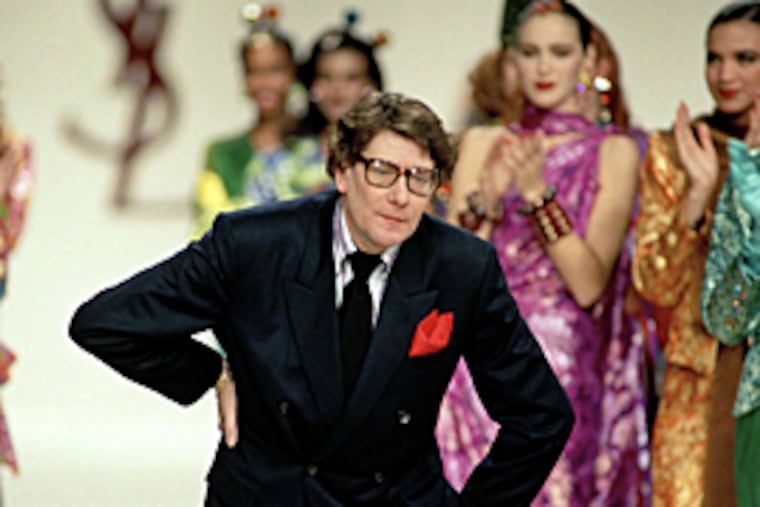YSL's lasting legacy
His designs, taken for granted today, made waves when they came down the runway.

To truly understand Yves Saint Laurent's contributions to modern-day women's wear, we have to get beyond the YSL luxury brand, the Opium perfume, the Mombasa handbag, the aviator frames.
Saint Laurent, 71, died Sunday at his Paris home after a long battle with brain cancer, and it would be remiss of us to remember him primarily for a logo. His clothes were far more important than that.
Without Saint Laurent, some of our favorite silhouettes might not exist: the A-line dress; the pantsuit; the belted safari jacket; the woman's tuxedo, better known as "Le Smoking"; the peasant look.
As one of fashion's original "fabulous ones," Saint Laurent dined with socialites, dressed Catherine Deneuve for the 1968 movie Belle du Jour, and clothed Bianca Jagger, Paloma Picasso and Lauren Bacall. He was one of the first designers to use African American models on the runway.
Coco Chanel may have given women freedom to move, but it was Saint Laurent who empowered them.
"Yves Saint Laurent was the most important designer of the 20th century," designer Diane von Furstenberg, president of the New York-based Council of Fashion Design, said yesterday. "He transformed the way women looked and felt. As a woman, he made me feel the way I wanted to feel. . . . He will always be a source of inspiration."
Because of Saint Laurent, said Jane Carton, former fashion director for Saks Fifth Avenue at Bala Cynwyd, "We [women] actually got the guts to start wearing pants."
"One day in the 1960s, I was meeting with some other women in the Union League and I was wearing a pair of Saint Laurent pants," Carton said. The man at the entrance "told me I couldn't come in wearing my pants. . . . I walked right on in, but that's how prehistoric it was. . . . We have so much to be thankful for with him."
Saint Laurent was born in Oran, Algeria, in 1936 to a father who was an insurance broker and a mother who was known for having great personal style. His parents wanted him to study law, but Saint Laurent attended the famed Chambre Syndicale de la Couture in Paris for a year before winning a competition and catching the eye of design eminence Christian Dior. He would intern at the House of Dior for three years.
In 1957, Dior died unexpectedly, and Saint Laurent became lead designer for the multimillion-dollar fashion house. The next year, at age 22, Saint Laurent showed his first collection for Dior, the Trapeze collection.
"My senior collection [in college] was inspired by Yves Saint Laurent," said Emil De John, fashion professor at the Art Institute of Philadelphia. "It was an olive-green cashmere jacket and A-line skirt that was the shape of the trapeze. I thought it was so sensational."
In 1960, Saint Laurent introduced the chic beatnik look, which included knit turtlenecks and black leather jackets, in his last collection for Dior.
Later that year, he went off to serve in the French-Algerian War. But in the military, Saint Laurent suffered a nervous collapse and was discharged two months later. In 1961, he opened his own haute-couture house with his financial partner and then lover, Pierre Berge.
Throughout his life, the designer suffered with drug and alcohol addictions. Yet season after season, he wowed the fashion world with looks that were revolutionary for their time - and are taken for granted today. His heyday may have been the 1960s, but his influence continues to be seen in the work of designers from Peter Som to Marc Jacobs to Michael Kors.
In 1965, Saint Laurent took the royal-blue, fire-engine red and taxi-cab yellow color blockings of Dutch painter Piet Mondrian and replicated the pattern on dresses, blouses and scarves. In 1976, he made peasant styles look like a million dollars through the use of rich fabrics.
Over the years, he'd give cachet to the trench coat, the peacoat (which he paired with white trousers), and leopard prints. In the mid-1960s, he launched a ready-to-wear line called Rive Gauche, to bring the look of haute couture to the masses.
In 1983, he became the first living designer to have a show dedicated to his work at the Metropolitan Museum of Art. The Philadelphia Museum of Art has more than 20 pieces by Saint Laurent at the new Perelman Building, ranging from his early styles with the House of Dior to his final designs from the early part of the millennium.
"The only reason that we have so much art in fashion now is because of Yves Saint Laurent," said Philadelphia-bred author Dana Thomas, author of Deluxe: How Luxury Lost Its Luster (Penguin Press, 2007).
"When you see a sharp shoulder, or a pop-art dress, that's all Saint Laurent. He created a new fashion vocabulary."
The business Saint Laurent built was sold off over the years to luxury-brands companies such as the Gucci Group, but Berge maintained control of the haute-couture division until 2002, when Saint Laurent retired.
The fashion world was devastated and mourned the end of an era. Even with Tom Ford designing some of the collection released under the Yves Saint Laurent brand, things would never be the same.
"He was one of the few who tried to hold on to pure fashion, but even he had to sell out," Thomas said. "When the company announced sales were down because [it] hadn't had a hit handbag, that was the ultimate sign. . . . That is not what Mr. Saint Laurent was about."
When a designer becomes better known for his global brand than for his work, the core of his fashion vision sometimes becomes lost. With Saint Laurent's stylistic point of view still reflected in the clothes we wear today, it would be a shame to forget the legacy behind the accessories.